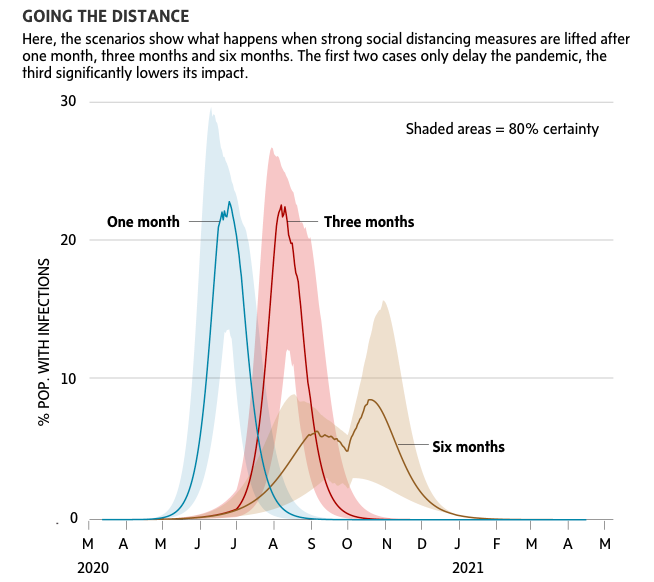
IVAN SEMENIUK
March 21, 2020
With schools closed, public events cancelled, entertainment venues shuttered and many people either not working or working from home because of the COVID-19 pandemic, the majority of Canadians are now living with the reality of social distancing.
But with the number of confirmed cases across the country topping 1,000 Friday, it’s clear that for decision-makers, this was the easy part. Faced with a population that has no immunity to the virus, growing evidence that the virus can be spread without symptoms, and a lack of vaccines or treatments, the only option to lessen the impact of the pandemic is to drastically reduce opportunities for human contact.
Much harder are the questions of how and when to emerge from the current state of isolation. It’s a decision that means weighing the serious health risk that the new coronavirus poses against the crushing impact of prolonged social distancing on the economy, jobs, education, and public life. It will also depend crucially on how long individuals are willing to maintain social-distancing practices.
In an effort to better understand the choices we face, The Globe and Mail worked with researchers at Simon Fraser University in British Columbia to develop a set of scenarios based on a mathematical model of the epidemic.

The model was initially created to forecast the possible spread of the virus in Vancouver. However, it could just as easily apply to any large Canadian city or densely populated region. Rather than numbers of confirmed cases, it shows the fraction of a population that is likely to be infected by the virus at any given time.
For this exercise, the model was used to generate a series of scenarios that explore the impact of social distancing and what happens when the strategy is finally ended.
Similar models are being used to inform choices by government leaders around the world. This week, a report by researchers at Imperial College London shocked Britain into accelerating its social-distancing measures and it was also viewed as a wake-up call in the United States, where case numbers have spiked sharply.
Such models have been criticized by some in the research community for being too pessimistic because their underlying assumptions play down the potential for a swift and decisive response to extinguish an outbreak. China’s apparent success at doing so, at least for now, shows that it may be possible to keep the pandemic at bay. Thousands of infections don’t have to become millions when measures to stop the spread of the virus are taken seriously.
Yet, all experts agree there is no chance of preventing rapid, widespread infection without immediate changes in social behaviour that last for several weeks to several months.
“It looks like the effectiveness with which people distance themselves is going to have a huge impact,” said Caroline Colijn, a professor at SFU and Canada 150 Research Chair in mathematics for evolution, infection and public health.
It looks like the effectiveness with which people distance themselves is going to have a huge impact
— Caroline Colijn
To examine what that means for Canada, Dr. Colijn tested a range of possible futures. Each begins in mid-March with a tiny fraction of the population infected by the virus.
Importantly, the scenarios show the high level of uncertainty that is built into models of this kind. Based on a slight difference in how easily the virus can be transmitted from one person to the next – a number that is not yet known to high precision – the fraction of the total population that is infected during the peak of infections can vary by as much as 15 per cent.
Another unknown is whether the virus will become less active during the summer months. This is what happens with seasonal flu, another respiratory virus, but the same effect can’t be assumed for a virus to which the human population has never been exposed. However, even if there is a seasonal effect, it would likely only serve to delay the trajectory of the outbreak rather than significantly change it.
Where the scenarios can provide some clarity is in the comparisons between different options for how much social distancing should be applied and for what length of time. Those comparisons are captured here.
WHY DISTANCING MATTERS
The basic strategy is simple. If everyone in the population is isolated from everyone else, the virus has nowhere to go and infections die out over the course of the incubation period of 14 days. In practice, it doesn’t work that way. Families will isolate together and it could take a number of weeks for a virus to move within a family group. And there is still a need for at least some people to be out and about performing essential services, including caring for the sick.

These three scenarios compare the trajectory of the pandemic when no measures are taken with what happens under medium and strong levels of social distancing. The measures are interconnected in complex ways. For example, school closings and work-from-home recommendations greatly reduce the spread of the virus between students and co-workers but increase the potential for household and local community contact as people spend more time in their own neighbourhoods. Shutdowns of social venues, including restaurants and cafés, can reduce contacts still further.
With no measures in place, infections rise quickly and reach their peak by about June. At that point, up to one-quarter of the population could be infected at the same time. In a large Canadian city, this would amount to hundreds of thousands of cases, many of them severe.
In the medium scenario, schools and some businesses remain open but social contact is reduced by up to 40 per cent. Here the peak is lowered somewhat and shifted by a month or so. The bigger difference comes if social-distancing measures are strong, with most places where people gathered closed for the duration of the pandemic. Then the height of the peak could be cut by more than one half and it doesn’t arrive until the early fall, by which time health facilities may be better able to meet the flood of new cases.
All three scenarios end with a significant fraction of the population having been infected one year from now. With no distancing, that amounts to more than 70 per cent of the population before the virus burns out. With strong distancing, it’s more likely to be less than half the population.

These scenarios show what happens when the strong distancing measures are lifted after one month, three months and six months. Whether distancing ends abruptly or gradually, there appears to be little benefit to ending the measures before the peak of the pandemic is over.
For example, ending after one month merely displaces the steep infection curve that occurs with no distancing by roughly the same amount of time. Ending after three months – about July 1 – spreads the peak out a bit more, but it still reaches 20 per cent of the population infected by the end of the summer. Only the six-month interval, which means lifting measures around Oct. 1, significantly breaks the shape of the infection curve. Here the range of uncertainty is greatest, with a few per cent to 15 per cent of the population infected late in the year.

On Thursday, Canada’s Chief Public Health Officer Theresa Tam said the country must not only flatten the infection curve but attempt to “plank” it. That means pursuing every possible measure to its fullest, including social distancing and rapidly identifying new cases and isolating anyone who may have been exposed to the virus.
In that scenario, the pandemic does not take off. While the cumulative number of cases may run into the thousands, it only amounts to a tiny fraction of the population. In the model, this means reducing all contacts outside of the household by more than 90 per cent. If it works, community infections could be kept relatively low.
This option would require even harsher measures than Canadians are already practising. And since the vast majority of the population still has no immunity to the virus, there remains a strong likelihood that the infection rate will soar as soon as measures are lifted. And even if the virus is extinguished within the community, there remains the risk of it being reintroduced from elsewhere.
This Globe and Mail article was legally licensed by AdvisorStream.
© Copyright 2025 The Globe and Mail Inc. All rights reserved.


